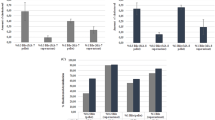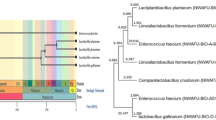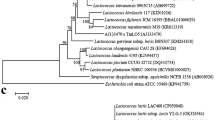Abstract
The aim of this study was to evaluate the cholesterol lowering ability of Lactic Acid Bacteria (LAB) isolated from human breast milk under in vitro and in vivo conditions. Six LAB isolates namely Lacticaseibacillus casei 1A, Lactobacillus gasseri 5A, Enterococcus faecium 2C, Limosilactobacillus fermentum 3D, Pediococcus acidilactici 1C, and Lactiplantibacillus plantarum 7A, were examined for their bile resistance, bile salt hydrolase activity, cholesterol assimilation and viability in cholesterol rich; DeMan Rogosa and Sharpe broth, simulated gastric, small and upper intestinal conditions. During in vivo experiments, two putative LAB isolates were orally gavage to BALB/c mice, fed with normal basal and cholesterol rich (HCD) diets, daily for a period of 4 weeks. Blood serum analysis including total serum cholesterol, triglycerides, high-density and low-density lipoprotein (LDL) cholesterol levels and total fecal LAB counts of the animals were determined. The isolates in study showed bile resistance and bile salt hydrolysis activity, while significant differences (P < 0.05) were seen in their cholesterol assimilation ability. L. gasseri 5A (195.67%) and L. plantarum 7A (193.78%) displayed highest cholesterol removal percentages, respectively. Animals in HCD, fed with L. gasseri 5A and L. plantarum 7A showed decreased levels of total cholesterol and LDL, compared to the control groups. In HCD group liver weight was increased, while fecal LAB counts were decreased. No changes were observed in behavior or body weight in all experimental groups. In conclusion, L. gasseri 5A and L. plantarum 7A isolated from human breast milk demonstrates significant hypocholesterolaemic actions in vitro and in vivo and might be considered a promising candidates for preventing hypercholesterolemia in man and animals.




Similar content being viewed by others
References
Jung E, Kong SY, Ro YS et al (2022) Serum cholesterol levels and risk of cardiovascular death: a systematic review and a dose-response meta-analysis of prospective cohort studies. Int J Environ Res Public Health 19:8272. https://doi.org/10.3390/ijerph19148272
Vaduganathan M, Mensah G, Turco J et al (2022) The global burden of cardiovascular diseases and risk. J Am Coll Cardiol 80:2361–2371. https://doi.org/10.1016/j.jacc.2022.11.005
Sivamaruthi BS, Bharathi M, Kesika P et al (2021) The administration of probiotics against hypercholesterolemia: a systematic review. J Appl Sci 11:6913. https://doi.org/10.3390/app11156913
Selva-O’Callaghan A, Alvarado-Cardenas M, Pinal-Fernández I et al (2018) Statin-induced myalgia and myositis: an update on pathogenesis and clinical recommendations. Expert Rev Clin Immunol 14:215–224
Gerards MC, Terlou RJ, Yu H et al (2015) Traditional Chinese lipid-lowering agent red yeast rice results in significant LDL reduction but safety is uncertain–a systematic review and meta-analysis. Atherosclerosis 240:415–423
Shahidi F (2012) Nutraceuticals, functional foods and dietary supplements in health and disease. J Food Drug Anal 20:226–230
Shin HS, Park SY, Lee DK et al (2010) Hypocholesterolemic effect of sonication-killed Bifidobacterium longum isolated from healthy adult Koreans in high cholesterol fed rats. Arch Pharm Res 33:1425–1431. https://doi.org/10.1007/s12272-010-0917-7
Gibson GR, Hutkins R, Sanders ME et al (2017) Expert consensus document: the international scientific association for probiotics and prebiotics (ISAPP) consensus statement on the definition and scope of prebiotics. Nat Rev Gastroenterol Hepatol 14:491–502
Lye HS, Kato T, Low WY et al (2017) Lactobacillus fermentum FTDC 8312 combats hypercholesterolemia via alteration of gut microbiota. J Biotechnol 262:75–83. https://doi.org/10.1016/j.jbiotec.2017.09.007
Marras L, Caputo M, Bisicchia S et al (2021) The role of bifidobacteria in predictive and preventive medicine: a focus on eczema and hypercholesterolemia. Microorganisms 9:836
Castorena-Alba MM, Vázquez-Rodríguez JA, López-Cabanillas Lomelí M et al (2018) Cholesterol assimilation, acid and bile survival of probiotic bacteria isolated from food and reference strains. CYTA J Food 16:36–41
Walker DK, Gilliland SE (1993) Relationships among bile tolerance, bile salt deconjugation, and assimilation of cholesterol by Lactobacillus acidophilus. J Dairy Sci 76:956–961
Pereira DI, Gibson GR (2002) Cholesterol assimilation by lactic acid bacteria and bifidobacteria isolated from the human gut. Appl Environ Microbiol 68:4689–4693
Khare A, Gaur S (2020) Cholesterol-Lowering Effects of Lactobacillus Species. Curr Microbiol 77:638–644
Khalkhali S, Mojgani N (2017) Characterization of candidate probionts isolated from human breast milk. Cell Mol Biol 63:82–88
Boix-Amorós A, Collado MC, Mira A (2016) Relationship between milk microbiota, bacterial load, macronutrients, and human cells during lactation. Front Microbiol 7:492
Argyri AA, Zoumpopoulou G, Karatzas KAG et al (2013) Selection of potential probiotic lactic acid bacteria from fermented olives by in vitro tests. Food Microbiol 33:282–291. https://doi.org/10.1007/s13213-017-1254-6
Hernández-Gómez JG, López-Bonilla A, Trejo-Tapia G et al (2021) In vitro bile salt hydrolase (BSH) activity screening of different probiotic microorganisms. Foods 10:674. https://doi.org/10.3390/foods10030674
Tomaro-Duchesneau C, Jones ML, Shah D et al (2014) Cholesterol assimilation by Lactobacillus probiotic bacteria: an in vitro investigation. Biomed Res Int. https://doi.org/10.1155/2014/380316
Chelliah R, Ramakrishnan SR, Prabhu PR et al (2016) Evaluation of antimicrobial activity and probiotic properties of wild-strain Pichia kudriavzevii isolated from frozen idli batter. Yeast 33:385–401
Kathade SA, Aswani MA, Anand PK et al (2020) Isolation of Lactobacillus from donkey dung and its probiotic characterization. Kor J Microbiol 56:160
Charteris C, Kelly K, Morelli M et al (1998) Development and application of an in vivo methodology to determine the transit tolerance of potentially probiotic lactobacillus and bifidobacterium species in the upper human gastrointestinal tract. J Appl Microbiol 84:759–768. https://doi.org/10.1046/j.1365-2672.1998.00407.x
Nallala VS, Jeevaratnam K (2019) Hypocholesterolaemic action of Lactobacillus plantarum VJC38 in rats fed a cholesterol-enriched diet. Ann Microbiol 69:369–376. https://doi.org/10.1007/s13213-018-1427-y
Damodharan K, Palaniyandi SA, Yang SH et al (2015) In vitro probiotic characterization of Lactobacillus strains from fermented radish and their anti-adherence activity against enteric pathogens. Can J Microbiol 61:837–850. https://doi.org/10.1139/cjm-2015-0311
Lee DK, Jang S, Baek EH et al (2009) Lactic acid bacteria affect serum cholesterol levels, harmful fecal enzyme activity, and fecal water content. Lipids Health Dis 8:21. https://doi.org/10.1186/1476-511X-8-21
Long SL, Gahan CGM, Joyce SA (2017) Interactions between gut bacteria and bile in health and disease. Mol Asp Med 5:1–12
Humphries SE, Cooper JA, Seed M et al (2018) Simon broome familial hyperlipidaemia register group. Coronary heart disease mortality in treated familial hypercholesterolaemia: update of the UK Simon Broome FH register. Atherosclerosis 274:41–46. https://doi.org/10.1016/j.atherosclerosis.2018.04.040
Lawrence RA, Lawrence RM, Breastfeeding. A guide for the medical profession. 8th Edition. Philadelphia: Elsevier, 2016
Asan-Ozusaglam M, Gunyakti A (2018) Lactobacillus fermentum strains from human breast milk with probiotic properties and cholesterol-lowering effects. Food Sci Biotechnol 28:501–509. https://doi.org/10.1007/s10068-018-0494-y
Sivamaruthi BS, Fern LA, Hj DS et al (2020) The influence of probiotics on bile acids in diseases and aging. Biomed Pharmacother 128:110310
Prete R, Long SL, Gallardo AL et al (2020) Beneficial bile acid metabolism from Lactobacillus plantarum of food origin. Sci Rep 10:1165. https://doi.org/10.1038/s41598-020-58069-5
Shehata MG, Sohaimy SE, El-Sahn MA et al (2016) Screening of isolated potential probiotic lactic acid bacteria for cholesterol lowering property and bile salt hydrolase activity. Ann Agric Sci 61:65–75. https://doi.org/10.1016/j.aoas.2016.03.001
Song Z, Cai Y, Lao X et al (2019) Taxonomic profiling and populational patterns of bacterial bile salt hydrolase (BSH) genes based on worldwide human gut microbiome. Microbiome 7:9. https://doi.org/10.1186/s40168-019-0628-3
Albano C (2018) Lactic acid bacteria with cholesterol-lowering properties for dairy applications: In vitro and in situ activity. Int J Dairy Sci 101:10807–10818
Wang J, Zhang H, Chen X et al (2012) Selection of potential probiotic lactobacilli for cholesterol-lowering properties and their effect on cholesterol metabolism in rats fed a high-lipid diet. J Dairy Sci 95:1645–1654. https://doi.org/10.3168/jds.2011-4768
Zanotti I, Turroni F, Piemontese A et al (2015) Evidence for cholesterol-lowering activity by Bifidobacterium bifidum PRL2010 through gut microbiota modulation. Appl Microbiol Biotechnol 99:6813–6829. https://doi.org/10.1007/s00253-015-6564-7
Madani G, Mirlohi M, Yahay M et al (2013) How much in vitro cholesterol reducing activity of lactobacilli predicts their in vivo cholesterol function? Int J Prev Med 4:404–413
Liu H (2013) Ability of lactic acid bacteria isolated from mink to remove cholesterol: in vitro and in vivo studies. Can J Microbiol 59:563–569
Pigeon RM, Cuesta EP, Gilliland SE (2002) Binding of free bile acids by cells acids by cells of yogurt starter culture bacteria. J Dairy Sci 85:2705–2710
Palaniyandi SA, Damodharan K, Suh JW et al (2020) Probiotic characterization of cholesterol-lowering lactobacillus fermentum MJM60397. Probiotics Antimicrob Proteins 12:1161–1172. https://doi.org/10.1007/s12602-019-09585-y
Yamasaki M, Minesaki M, Iwakiri A et al (2020) Lactobacillus plantarum 06CC2 reduces hepatic cholesterol levels and modulates bile acid deconjugation in BALB/c mice fed a high-cholesterol diet. Food Sci Nutr 8:6164–6173. https://doi.org/10.1002/fsn3.1909
Author information
Authors and Affiliations
Corresponding author
Ethics declarations
Conflict of interest
The authors declare that they have no conflict of interest.
Human and Animal Participants
All applied procedures related to animals were approved by the Animal Ethic Committee, Razi vaccine and Serum Research Institute, and the experiments were performed according to the animal care and welfare regulations.
Additional information
Publisher's Note
Springer Nature remains neutral with regard to jurisdictional claims in published maps and institutional affiliations.
Rights and permissions
Springer Nature or its licensor (e.g. a society or other partner) holds exclusive rights to this article under a publishing agreement with the author(s) or other rightsholder(s); author self-archiving of the accepted manuscript version of this article is solely governed by the terms of such publishing agreement and applicable law.
About this article
Cite this article
Mojgani, N., Bagheri, M. & Vaseji, N. Invitro and Invivo Analysis of Human Milk Lactic Acid Bacteria Isolates for Their Anti-hypercholesterolemia Actions. Indian J Microbiol 64, 175–185 (2024). https://doi.org/10.1007/s12088-023-01150-0
Received:
Accepted:
Published:
Issue Date:
DOI: https://doi.org/10.1007/s12088-023-01150-0




